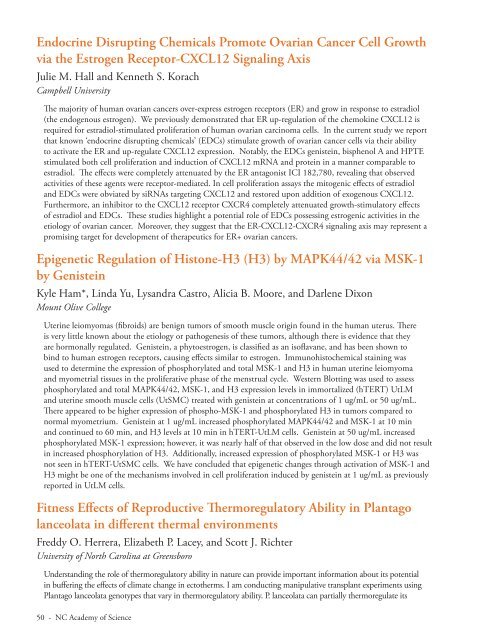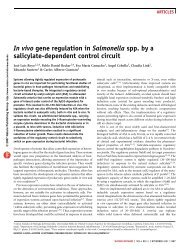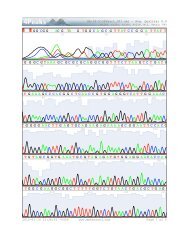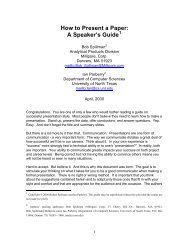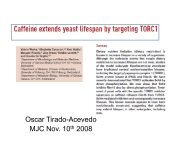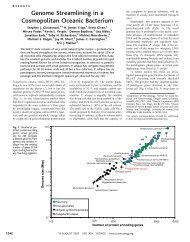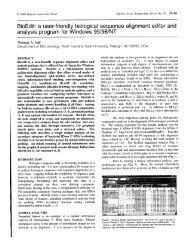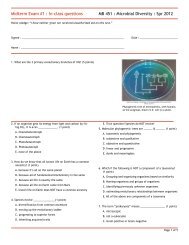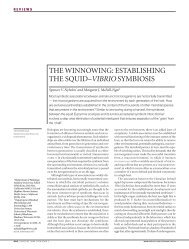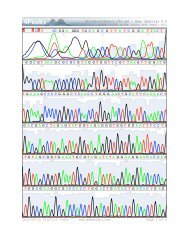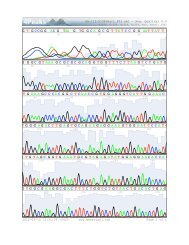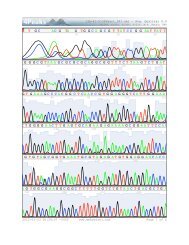Schedule and Program - North Carolina Academy of Science
Schedule and Program - North Carolina Academy of Science
Schedule and Program - North Carolina Academy of Science
Create successful ePaper yourself
Turn your PDF publications into a flip-book with our unique Google optimized e-Paper software.
Endocrine Disrupting Chemicals Promote Ovarian Cancer Cell Growthvia the Estrogen Receptor-CXCL12 Signaling AxisJulie M. Hall <strong>and</strong> Kenneth S. KorachCampbell UniversityThe majority <strong>of</strong> human ovarian cancers over-express estrogen receptors (ER) <strong>and</strong> grow in response to estradiol(the endogenous estrogen). We previously demonstrated that ER up-regulation <strong>of</strong> the chemokine CXCL12 isrequired for estradiol-stimulated proliferation <strong>of</strong> human ovarian carcinoma cells. In the current study we reportthat known ‘endocrine disrupting chemicals’ (EDCs) stimulate growth <strong>of</strong> ovarian cancer cells via their abilityto activate the ER <strong>and</strong> up-regulate CXCL12 expression. Notably, the EDCs genistein, bisphenol A <strong>and</strong> HPTEstimulated both cell proliferation <strong>and</strong> induction <strong>of</strong> CXCL12 mRNA <strong>and</strong> protein in a manner comparable toestradiol. The effects were completely attenuated by the ER antagonist ICI 182,780, revealing that observedactivities <strong>of</strong> these agents were receptor-mediated. In cell proliferation assays the mitogenic effects <strong>of</strong> estradiol<strong>and</strong> EDCs were obviated by siRNAs targeting CXCL12 <strong>and</strong> restored upon addition <strong>of</strong> exogenous CXCL12.Furthermore, an inhibitor to the CXCL12 receptor CXCR4 completely attenuated growth-stimulatory effects<strong>of</strong> estradiol <strong>and</strong> EDCs. These studies highlight a potential role <strong>of</strong> EDCs possessing estrogenic activities in theetiology <strong>of</strong> ovarian cancer. Moreover, they suggest that the ER-CXCL12-CXCR4 signaling axis may represent apromising target for development <strong>of</strong> therapeutics for ER+ ovarian cancers.Epigenetic Regulation <strong>of</strong> Histone-H3 (H3) by MAPK44/42 via MSK-1by GenisteinKyle Ham*, Linda Yu, Lys<strong>and</strong>ra Castro, Alicia B. Moore, <strong>and</strong> Darlene DixonMount Olive CollegeUterine leiomyomas (fibroids) are benign tumors <strong>of</strong> smooth muscle origin found in the human uterus. Thereis very little known about the etiology or pathogenesis <strong>of</strong> these tumors, although there is evidence that theyare hormonally regulated. Genistein, a phytoestrogen, is classified as an is<strong>of</strong>lavane, <strong>and</strong> has been shown tobind to human estrogen receptors, causing effects similar to estrogen. Immunohistochemical staining wasused to determine the expression <strong>of</strong> phosphorylated <strong>and</strong> total MSK-1 <strong>and</strong> H3 in human uterine leiomyoma<strong>and</strong> myometrial tissues in the proliferative phase <strong>of</strong> the menstrual cycle. Western Blotting was used to assessphosphorylated <strong>and</strong> total MAPK44/42, MSK-1, <strong>and</strong> H3 expression levels in immortalized (hTERT) UtLM<strong>and</strong> uterine smooth muscle cells (UtSMC) treated with genistein at concentrations <strong>of</strong> 1 ug/mL or 50 ug/mL.There appeared to be higher expression <strong>of</strong> phospho-MSK-1 <strong>and</strong> phosphorylated H3 in tumors compared tonormal myometrium. Genistein at 1 ug/mL increased phosphorylated MAPK44/42 <strong>and</strong> MSK-1 at 10 min<strong>and</strong> continued to 60 min, <strong>and</strong> H3 levels at 10 min in hTERT-UtLM cells. Genistein at 50 ug/mL increasedphosphorylated MSK-1 expression; however, it was nearly half <strong>of</strong> that observed in the low dose <strong>and</strong> did not resultin increased phosphorylation <strong>of</strong> H3. Additionally, increased expression <strong>of</strong> phosphorylated MSK-1 or H3 wasnot seen in hTERT-UtSMC cells. We have concluded that epigenetic changes through activation <strong>of</strong> MSK-1 <strong>and</strong>H3 might be one <strong>of</strong> the mechanisms involved in cell proliferation induced by genistein at 1 ug/mL as previouslyreported in UtLM cells.Fitness Effects <strong>of</strong> Reproductive Thermoregulatory Ability in Plantagolanceolata in different thermal environmentsFreddy O. Herrera, Elizabeth P. Lacey, <strong>and</strong> Scott J. RichterUniversity <strong>of</strong> <strong>North</strong> <strong>Carolina</strong> at GreensboroUnderst<strong>and</strong>ing the role <strong>of</strong> thermoregulatory ability in nature can provide important information about its potentialin buffering the effects <strong>of</strong> climate change in ectotherms. I am conducting manipulative transplant experiments usingPlantago lanceolata genotypes that vary in thermoregulatory ability. P. lanceolata can partially thermoregulate its50 - NC <strong>Academy</strong> <strong>of</strong> <strong>Science</strong>


